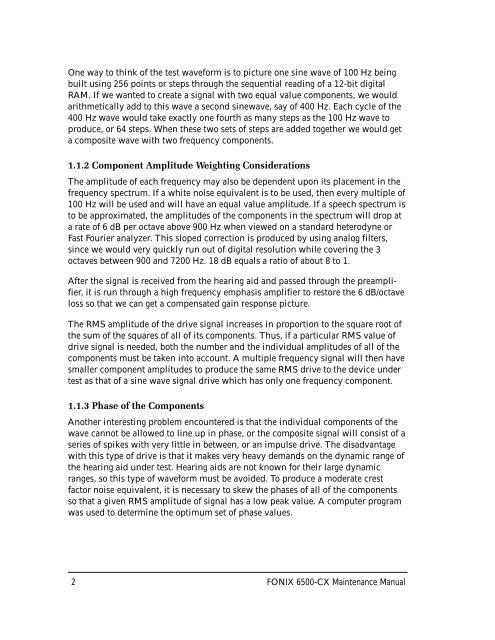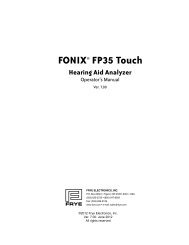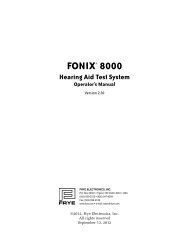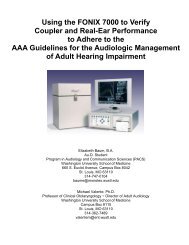6500-CX Hearing Aid Test System - Frye Electronics
6500-CX Hearing Aid Test System - Frye Electronics
6500-CX Hearing Aid Test System - Frye Electronics
You also want an ePaper? Increase the reach of your titles
YUMPU automatically turns print PDFs into web optimized ePapers that Google loves.
One way to think of the test waveform is to picture one sine wave of 100 Hz being<br />
built using 256 points or steps through the sequential reading of a 12-bit digital<br />
RAM. If we wanted to create a signal with two equal value components, we would<br />
arithmetically add to this wave a second sinewave, say of 400 Hz. Each cycle of the<br />
400 Hz wave would take exactly one fourth as many steps as the 100 Hz wave to<br />
produce, or 64 steps. When these two sets of steps are added together we would get<br />
a composite wave with two frequency components.<br />
1.1.2 Component Amplitude Weighting Considerations<br />
The amplitude of each frequency may also be dependent upon its placement in the<br />
frequency spectrum. If a white noise equivalent is to be used, then every multiple of<br />
100 Hz will be used and will have an equal value amplitude. If a speech spectrum is<br />
to be approximated, the amplitudes of the components in the spectrum will drop at<br />
a rate of 6 dB per octave above 900 Hz when viewed on a standard heterodyne or<br />
Fast Fourier analyzer. This sloped correction is produced by using analog filters,<br />
since we would very quickly run out of digital resolution while covering the 3<br />
octaves between 900 and 7200 Hz. 18 dB equals a ratio of about 8 to 1.<br />
After the signal is received from the hearing aid and passed through the preamplifier,<br />
it is run through a high frequency emphasis amplifier to restore the 6 dB/octave<br />
loss so that we can get a compensated gain response picture.<br />
The RMS amplitude of the drive signal increases in proportion to the square root of<br />
the sum of the squares of all of its components. Thus, if a particular RMS value of<br />
drive signal is needed, both the number and the individual amplitudes of all of the<br />
components must be taken into account. A multiple frequency signal will then have<br />
smaller component amplitudes to produce the same RMS drive to the device under<br />
test as that of a sine wave signal drive which has only one frequency component.<br />
1.1.3 Phase of the Components<br />
Another interesting problem encountered is that the individual components of the<br />
wave cannot be allowed to line up in phase, or the composite signal will consist of a<br />
series of spikes with very little in between, or an impulse drive. The disadvantage<br />
with this type of drive is that it makes very heavy demands on the dynamic range of<br />
the hearing aid under test. <strong>Hearing</strong> aids are not known for their large dynamic<br />
ranges, so this type of waveform must be avoided. To produce a moderate crest<br />
factor noise equivalent, it is necessary to skew the phases of all of the components<br />
so that a given RMS amplitude of signal has a low peak value. A computer program<br />
was used to determine the optimum set of phase values.<br />
2 FONIX <strong>6500</strong>-<strong>CX</strong> Maintenance Manual
















